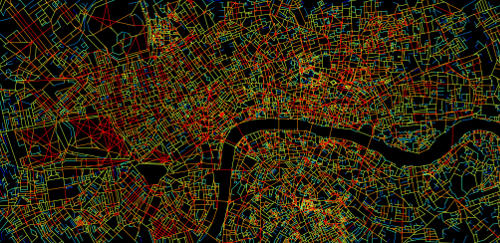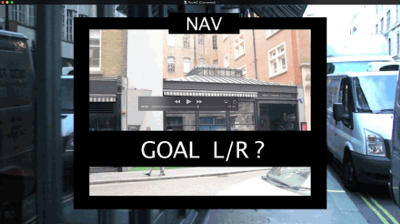Special Issue: Water Narratives
24 December 2025
Published online 26 March 2017
New techniques in experimental psychology show complex brain interactions behind memory and strategy when we navigate.

© Joao Pinelo Silva
Enlarge image
Cognitive neuroscience suggests that the mind creates internal maps of space that help us remember the past but also imagine the future. The mind in effect has an internal GPS system, in which neurons known as place cells signal location through their activity patterns, and inform us how different parts of the environment are connected.
Now, experiments at University College London combine virtual reality, functional magnetic resonance imaging (fMRI) and techniques from the cutting edge of architecture to show how two parts of the brain, the hippocampus and the prefrontal cortex, work together to understand the topology of street networks, simulate accessible future paths and decide upon a route to a goal.
The research, published in Nature Communications, brings a greater understanding of not only how our spatial memory operates, but perhaps how we remember and adjudicate upon our wider experiences to form judgements about our futures more generally.
In short, if our self is formed of experiences, it gives us an insight into how the brain tells us who we are.
How does the brain react to unfolding spaces in which visibility is, in effect, continuous? Where do street networks, which branch, and branch again, begin and end?
“Nobody had asked about how streets are connected and how that might affect the brain, or how the brain might use that information,” says Hugo Spiers, whose laboratory at UCL’s Institute of Neuroscience conducted the research.
"This study is an excellent example of the role of the hippocampus in everyday memory."
Spiers put together a multidisciplinary team of architects, cognitive scientists and experimental psychologists to correlate brain activity with an analysis of spatial configurations known as Space syntax, an alternative idea in architecture and design pioneered in the late 1970s by The Bartlett, UCL.
“Space syntax is based on a rigorous mathematical description of any space as a network of subspaces,” says Joao Pinelo Silva, an architect at the University of Bahrain who trained at the Bartlett. “Some spaces will be closer to all other spaces. If we imagine a city as a vast network where each street represents one node, then we can quantify the accessibility of each of the streets independently, based on its topology.”
This is done in several ways: by ‘degree’ (how many other streets a street interconnects with), by ‘closeness’ (how close it is relative to other streets) and by ‘betweenness’ (how much it is used to connect with all other streets).
In Bahrain, Pinelo Silva’s work is helping to increase the resilience of the road network by identifying the weakest nodes, those streets that create the most disruption if blocked by an accident or flooding. Back in London’s Soho, Pinelo Silva and his colleagues applied the same modelling techniques for Spiers’ neuroscience experiment.
Spiers got 24 people to learn the layout of part of Soho, and then scanned their brains while submerged in a virtual world representation of new routes through these streets. In half of these routes they were given a navigation task. The team then mapped these fMRI images onto space syntax measurements.
What Spiers found was striking: two different areas of the right-hand side of the hippocampus tracked different measurements of accessibility. The front right hippocampus activity pattern corresponds with closeness, tracking the details of the actual street that participants entered. Rear right hippocampal activity correlated with changes in degree – it simulates the number of future routes possible.
When participants are forced to take detours, the re-planning process engages areas of the prefrontal cortex, a region of the brain responsible for evaluating potential futureactions. This activity increases with the difficulty of the detour.
For Cambridge neuroscientist Rik Henson at MRC Brain and Cognition Sciences Unit, the study is an important step forward in understanding the role of the hippocampus in navigation.
The next stage would be to build an artificial neural-network.
Such computational models, which have been used to explain the properties of place cells in rodents, would simulate cell firing and give us a better resolution of the dynamics of what’s going on in the hippocampus.
The hippocampus is known to be important in the storage and retrieval of spatial memory.

© Javadi, AH et al.
“The observed distinction between posterior and anterior hippocampus is consistent with a major current theme in research on distinct functions of subdivisions of the hippocampus in the specificity or generality of memory, showing that the posterior hippocampus processes specific detailed memories whereas the anterior hippocampus processes generalities of the context of memories.
"If I asked where you were this morning, memory for the response ‘at home’ would be generated by the anterior hippocampus and memory for ‘sitting at the kitchen counter drinking coffee’ would be generated by the posterior hippocampus.”
Eichenbaum’s work, published most recently in the Annual Review of Psychology, suggests that the interaction of the hippocampus and the prefrontal cortex plays an important role not only in spatial navigation, but in the organization of memory and experience more generally. The hippocampus and its interactions therefore may represent a system supporting a broad range of cognitive maps of events and their relation to one another in time or other dimensions, such as social space.
“The findings confirm in this navigational setting, the role of the prefrontal cortex in the control of memory retrieval. The prefrontal cortex is well known as adjudicating opposing perceptions, behaviors, strategies, and memories,” he says. “In this study, the prefrontal cortex is engaged in the process of adjudicating alternative memories for routes.”
Spiers and his colleagues are interested in non spatial representations. “Many studies we drew upon show that the hippocampus simulates the future generally," says Spiers.
For now, he's using his expertise in neuroscience in construction and town planning to improve the way we build the environment around us.
Studies in familiarity and interpersonal differentiation in spatial navigation are also underway.
doi:10.1038/nmiddleeast.2017.51
Stay connected: